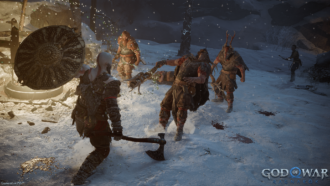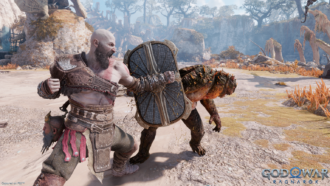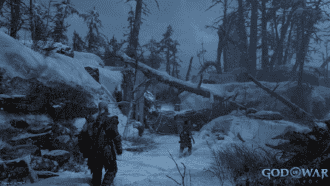Platforms:
PS4, PS5
Released:
November 9, 2022
Publisher:
Sony Interactive Entertainment
Developer:
SIE Santa Monica Studio
Not many would question that God of War (2018) is one of the most successful franchise “reboots” in history, taking a strong action-adventure series and propelling it into a new cinematic experience. It captured the feeling of the best AAA blockbusters with a heart and soul that reframed its violent hero Kratos into a caring, protective (and still violent) father figure when it comes to his son Atreus. It set an incredibly high bar for the future of the series and raised the stakes when it comes to that perfect combination of gameplay and storytelling. With that in mind, God of War Ragnarök has the unenviable task of living up to those high expectations, continuing Kratos and Atreus’ story. Brilliantly, Ragnarök does this in a meaningful way, offering further insight into their complex relationship while bringing plenty of new gameplay ideas to the table to enhance what was already a refined, thrilling escapade. God of War Ragnarök again nails the balance between emotional narrative and compelling game design, adding another absolute must-play to the PlayStation Studios catalogue.
I’ll do my absolute best to prevent story spoilers in this review, as I’d hate for you to not experience the big reveals as I was able to.
After the events of the last God of War (which are available to watch in a brief recap that sets the scene), Ragnarök starts off with Kratos already inheriting many enemies and ghosts from his past. Freya is still grieving the loss of her son, and she is seeking revenge on Kratos for killing him in the first place, even though he did so to save her. Beyond that, Odin still looms, and of course his son Thor, the God of thunder in burly intimidating form, is an ever-threatening presence watching over proceedings. Atreus is now older and more eager than ever to live up to his identity and his lineage, along with trying to maintain his role as peacekeeper from his more-aggressive Dad. The dynamic between father and son is as rich as ever, with Kratos struggling between being a father and thinking like a warrior general, with Atreus still eager to prove his worth and follow his own instincts.
God of War Ragnarök presents a touching story with plenty of heartfelt moments; again, without spoiling anything, I got misty-eyed in the game’s opening moments, and the emotional gut-punches are a relatively regular occurrence. It’s certainly not without a sense of humour; Mimir, the severed head that tags along throughout the journey, provides a lot of levity, as do returning dwarven brothers Sindri and Brok. In fact, all of these characters (and some new characters I won’t spoil) get moments in the spotlight in different ways, adding much more depth to the cast overall. Undoubtedly, Ragnarök is still largely about the growing tension between Kratos and Atreus, but it also revels in the “smaller” moments with its supporting ensemble; you feel like you are getting to know the whole family here, with Kratos’ grizzly demeanour slowly peeling away with each sweet interaction.
“…you’re forced to linger closely on tough scenes and let what’s happening in front of you really marinate.”
Of course, the voice talent involved do a fantastic job of bringing these characters to life and tugging on the heartstrings. Christopher Judge and Sunny Sljic as the main duo are a strong foundation, but Richard Schiff does a lot of heavy lifting as Odin, and Ryan Hurst adds a lot of layers to what could have been presented as a one-dimensional character with Thor. Similar to its predecessor, cut scenes merge with gameplay seamlessly in one continuous shot, which means that you’re forced to linger closely on tough scenes and let what’s happening in front of you really marinate. It’s still impressive on a technical level just how effortless it all feels, with battles and key action set-pieces merging with cinematic events like it’s no big deal at all. It might not feel quite as special as the first time Santa Monica Studio pulled it off, but it still manages to create awe-inspiring moments at every turn that puts the series in a real league of its own.
Visually, the game’s stunning throughout. While it may be “still available on the last generation of console” given the availability on PS4, the idea that it’s held back by this is just plain untrue. God of War Ragnarök is one of the best-looking games I’ve ever played in my life, from gorgeous lush greenery and glowing crystals in the Elven realm of Alfheim to the beautiful dwarven landscapes of Svartalfheim and everything in between. You can see the souls of the characters behind their eyes, and the little details and textures across the environment, whether it’s the shimmer of water or the ice that accumulates on your axe, make the world feel like a living, breathing, inhabitable space across all the realms you’ll visit. When it comes to atmosphere and feeling, it’s unmatched by any other game.
It’s all underpinned by yet another immersive soundtrack from composer Bear McCreary, that is poignant and emotional during the serious moments, but uplifting and triumphant after a key discovery or victorious battle. Ragnarök does a lot of heavy storytelling and the score manages to heighten every emotion.
The opening moments of the game might feel like a bit of a retread, with Kratos following a relatively linear path with Atreus by his side, carving through enemies, solving puzzles and progressing through the world in front of you. Initially, you’re hiding away at home in a protected area, but it’s not long before you’re thrust into the story and forced to travel, re-aligning with your party of aforementioned adventurers along the way. Here, in Svartalfheim, you re-learn the ropes as the world opens up, and you’re given the choice to either explore a side quest or persist with the main story. Much like the original, exploring these optional missions allows for rewards in the form of upgrades or resources for levelling up your gear, but they also offer insight into the realms and characters you’re travelling with that add additional context. An early diversion forces Mimir into some unwanted reflection, and there are some really lovely moments between father and son, where Atreus begins to wonder if Kratos perhaps is more sensitive than he thought.
The rhythm of exploring hidden locations, finding Nornir chests and unlocking them with a rune puzzle, helping restless spirits, and discovering hidden goodies feels like slipping back into a cozy and loved pair of pyjamas; considering how God of War (2018) established its universe so strongly, expecting these foundations to be drastically rocked wouldn’t have made a lot of sense. Giant puzzle areas with plenty of moving parts to find the solution with a sprinkling of combat in-between is a formula that works, and there’s a great balance in terms of difficulty, allowing for plenty of “a-ha!” moments as you progress and complete them.
Of course, Kratos is still a badass when it comes to ripping through foes, and Ragnarök instantly feels a lot more flexible in its approach to combat due to the fact that you begin the game with the ice-based Leviathan Axe (still super satisfying to call back to your hand after a throw), and the fiery Blades of Chaos that were acquired later in God of War (2018). Both weapons have their own distinct style, the Leviathan slower and with less range but really packing a hard punch, compared with the faster and further-reaching Blades. The Ice and Fire elements of each mean that certain enemies will be weaker to one than the other, so switching between them on the fly is important, while also being a lot of fun. Charging up the axe with a burst of ice before smashing it into a baddie feels great, and spinning the Blades in order to wind them up for more fire damage instantly makes combat dynamic. Every blow feels impactful, and having a companion fighting alongside you that you can direct adds yet another layer of depth.
Enemies, too, are varied in their approach. Apart from figuring out their initial weakness, they also attack with clear patterns, with most battle stages mixing melee and ranged attacks with plenty of opportunity for Kratos to dash and grapple his way around the place. In a one-on-one battle, things are pretty simple, but the areas that have multiple different enemy types scattered across them gives you a power trip as you’re leaping from one monster to the next, hacking their head off with your axe, stabbing them deep through the gut with your blades or simply picking them up and ripping them in half with your bare hands. It’s not afraid to get violent and visceral, with some pretty gnarly finishers that are custom depending on the weapon you’re holding and the enemy you’re up against.
Combat can be bloody tough at times, and you’ll be tested even on the average difficulty setting, especially if you’re not prepared. Parrying an attack still gives you an opening for retaliation, but some of the tougher enemies are relentless in their assault. Thankfully, there are mid-battle checkpoints for some of the trickier bosses, which is a huge relief. Figuring out how to use your rage effectively (whether it be for healing or for a devastating finishing blow) becomes crucial, as there aren’t always health resources laying about. Difficulty can also be changed at any time, but I really enjoyed the challenge presented; it doesn’t feel unfair but really does push you to your limits at times, forcing you to think quickly and adapt with your multiple weapons and abilities.
In between your bouncing around the various realms, Sindri’s house acts as a hub of sorts, where your band of travellers rests and allows for the opportunity to craft and upgrade your gear. The more you explore, the more resources you’ll find, but there are a lot of options here which means it’s far more in-depth than just choosing the highest numbers. Each gear piece has its own attributes, with focuses on strength, vitality, rune power and more, and I often found myself with a difficult decision on my hands as to whether it was worth spending resources to upgrade my current piece or craft something new entirely, including weapon parts (like handles) to bolster them further.
Upgrading Kratos and his companions unlocks more combos that can be used in battles, but the more powerful abilities you’ll uncover can’t all be used at once, which nudges you to try different styles, and I found myself trying my best to keep both of my weapons relatively levelled up together so that I could easily swap between them. Another wrinkle is that these abilities and combos also level up the more that you use them, getting stronger, so it’s worth focusing on the ones you love as much as possible, and you can focus upgrades on damage, stun attacks, runic attacks, or defence, so there’s lots to consider that keeps things fresh and adaptive to your play style.
“…a journey that’s full of surprises both narratively and within its secrets that are begging to be uncovered…”
I’m going to head into a territory in this next section that some might consider a “spoiler”, but it becomes a large part of the game, so skip the next three paragraphs if you’re super concerned.
In what might be expected by some, Atreus gets to strike out on his own as a fully playable character, without Kratos by his side. There’s plenty of narrative reasoning for this that I will not go into, but it makes complete sense as an arc for him to want to prove himself and live up to his father’s lofty expectations of him as a person and as a warrior. This also made me like Atreus a lot more and enjoy his company, much more than in the first game where he felt like more of a tag-along.
Atreus is certainly no slouch in combat, either. He’s more arrow-focused than Kratos, and he feels more scrappy in nature by the fact that he is smaller in stature, which also means he’s more nimble and can chain together faster strikes, quick dodges, and then create distance between himself and enemies for ranged attacks. A mixture of arrow types allows for the same focus on weaknesses that Kratos deals with in his Ice and Fire. His abilities are also a bit more magical in general, as he’s able to summon a beast spirit to temporarily ride and attack for him, and an ultimate ability I won’t spoil that also turns out to be a difference-maker. He also has his own ability tree to be upgraded.
Additionally, playing as Atreus allows him to truly step out of his father’s shadow. He grows a lot throughout Ragnarök, and being able to step into his shoes makes you feel a lot of that growth; he’s certainly not the same kid we saw four years ago, and he is incredibly likeable and in touch with the natural world around him, offering a more optimistic perspective on the world than his grumpy ol’ papa. It’s not just one token segment where you’ll play as the boy, but several that make sense with the story, which switches the style of gameplay up at key moments that keeps you really invested and means you won’t be too comfortable for too long.
The real beauty of the puzzle/exploration/combat gameplay loop is how God of War Ragnarök manages to iterate and evolve as it goes on, continually introducing new elements to solve puzzles and adding more layers to combat. It means you’re learning and adapting to surroundings, to the point where by the end of the game you’ll have many different tools in your arsenal, but won’t feel overwhelmed as they’re introduced cleverly and within context of the environment you’re in. For example, early on you’ll encounter sigils that aren’t accessible without a particular companion, or random little geysers protruding from walls with inaccessible areas just beyond them. Another new material is introduced that allows axe throws to reflect and bounce off of them.
The game encourages further exploration and revisiting when you do eventually get access to the right abilities or equipment, and leaves plenty of nuggets worth seeking out later. The more devilish late-game challenges encourage you to combine everything you’ve learned along the way, but you’ll feel incredibly prepared for the task at hand. It’s also just painfully clever how these additions influence both puzzles and combat together; for example, that reflective surface means your axe can rebound and hit enemies for extra damage, if you’re clever. Nothing serves just the one purpose, and everything has its place, that keeps the experience feeling fresh even after 30-40 hours. Just another testament to the incredible game design throughout.
I could go on about other elements that make God of War Ragnarök truly special, but really if I did that I’d be ruining some moments that had me dropping my jaw, reacting with audible gasps or simply saying “Wow” to myself as I discovered just another awesome thing in front of me, and I want you to experience those moments for yourself. It’s a journey that’s full of surprises both narratively and within its secrets that are begging to be uncovered, with side quests that give you even more reason to love this cast of misfits as they uncover their destiny and figure out whether their prophecy is one that can be altered. It’s both endlessly endearing and incredibly exciting, and after its satisfying-yet-intriguing conclusion, I can’t wait to see where the franchise goes next.
10
Masterpiece
Positive:
- Heartfelt, captivating story with a lovable cast of characters
- Engaging world to explore with lots of intriguing diversions
- Combat has a lot of depth and versatility
- Visually stunning with high production values
- Satisfying gameplay loop with some unexpected twists along the way
Negative:
- Doesn't necessarily innovate in the same way its predecessor did
God of War Ragnarök is more of the epic God of War that we loved in 2018, but it builds on those foundations in every single way to create a compelling and addicting adventure in its own right that improves across the board. Combat is furious and intense, exploring every nook and cranny of each Norse realm is captivating, and clever puzzles are seamlessly intertwined with abilities that change, evolve, and make you feel like a master of all crafts. Narratively, the heartfelt and fascinating story is supported by incredible writing that makes its whole cast of characters shine, and the production values are through the roof, with a gorgeous soundtrack and visuals that push the limits and stun at every turn. Santa Monica Studio have again managed to create something truly memorable and entirely special.























